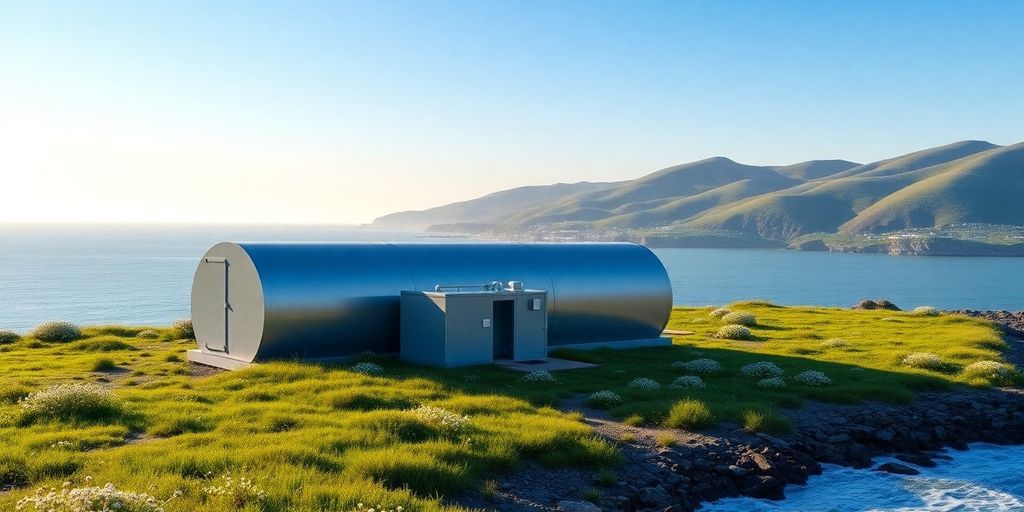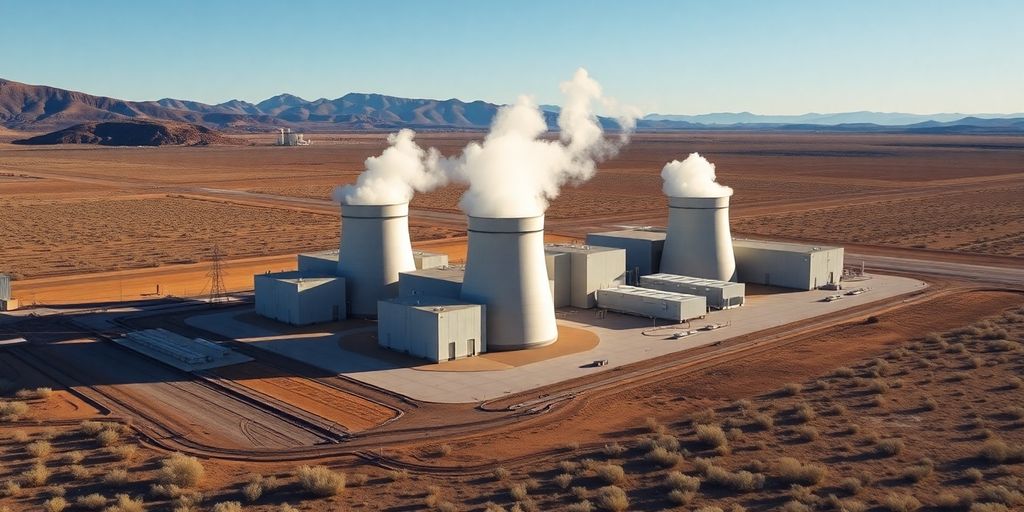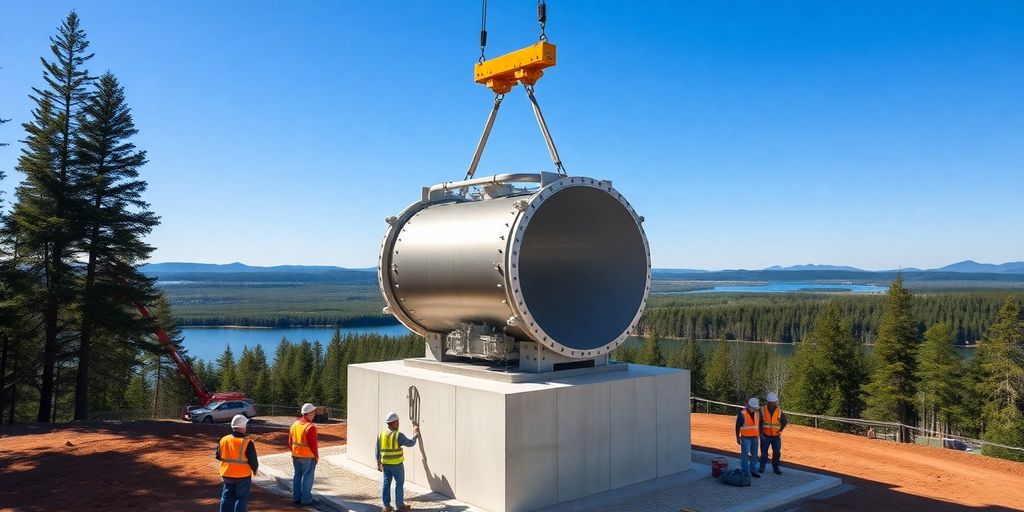I’ve been reading up on Small Modular Reactors (SMRs) lately and they really caught my attention. These compact nuclear units are built in factories, shipped to sites and assembled like big LEGO sets. That cuts construction time and cost compared to traditional plants. They also pack new safety features, use less land and water, and promise lower carbon emissions. Sure, they still need approvals and local buy-in, but SMRs could be a game-changer for clean, reliable power.
Key Takeaways
- Factory-built modules speed up construction and cut capital costs
- Passive safety systems and smaller cores lower accident risk
- Smaller footprint and lower emissions help the environment
- Streamlined licensing and global collaboration speed approvals
- Flexible setups suit microgrids, remote areas and pairing with renewables
Advancements Driving Small Modular Reactors (SMRs)
SMRs are getting a lot of buzz, and for good reason. They’re not just smaller versions of old reactors; they’re packed with new tech that could really change how we think about nuclear power. Let’s take a look at some of the key advancements.
Modular Manufacturing Techniques
One of the biggest things about SMRs is how they’re made. Instead of building everything on-site like with traditional reactors, SMRs are designed to be built in factories. Think of it like assembling a car – you make the parts in a controlled environment and then put them together. This approach can seriously cut down on construction time and costs. It also allows for better quality control, since everything is made under factory conditions. Plus, you can ship these modules pretty much anywhere, which opens up a lot of possibilities for where you can put a reactor.
Innovative Safety Systems
Safety is always a top concern with nuclear energy, and SMRs are designed with that in mind. They often include passive safety systems, which means they don’t need active controls or human intervention to shut down in an emergency. For example, some SMRs use natural convection to cool the reactor core, so if the power goes out, the reactor can still cool itself down. This is a big deal because it reduces the risk of accidents. These advanced nuclear units are also often built underground, adding another layer of protection.
Advanced Fuel Cycle Technologies
SMRs are also exploring new ways to handle nuclear fuel. This includes using different types of fuel that are more efficient or produce less waste. Some designs are even looking at using spent fuel from traditional reactors as fuel for SMRs, which could help reduce the amount of nuclear waste we have to store. Plus, some SMRs are designed to operate for longer periods between refueling, which means less downtime and lower operating costs. This focus on fuel fabrication and management is a key part of making SMRs a more sustainable energy option.
SMRs are not just about making nuclear power smaller; they’re about making it safer, cheaper, and more sustainable. These advancements are what make SMRs a promising option for the future of energy.
Economic Viability of Small Modular Reactors (SMRs)
Okay, so let’s talk money. Nuclear energy, especially the big plants, has always been a huge investment. SMRs are trying to change that, and honestly, it’s a big part of why people are excited about them. It’s not just about being green; it’s about being affordable, too.
Reduced Capital Expenditure
One of the biggest hurdles with traditional nuclear plants is the massive upfront cost. We’re talking billions of dollars and years of construction. SMRs aim to slash that. The idea is that because they’re smaller and modular, they can be built in factories and then shipped to the site. This cuts down on construction time and all the associated expenses. Think of it like building with LEGOs instead of pouring concrete for a skyscraper. It’s supposed to be way cheaper and faster. The modular design of SMRs allows for incremental capacity additions. Utilities can start with a smaller initial investment and add additional modules as demand grows, providing a scalable and adaptable energy solution that can evolve with changing energy needs.
Flexible Financing Models
Because the initial investment is lower, it opens up different ways to pay for these things. You’re not necessarily stuck with needing a huge government loan or a consortium of massive corporations. Maybe smaller companies can get involved, or even local communities could invest. It makes the whole thing more accessible. The high upfront cost of constructing large nuclear reactors has been a significant barrier to the expansion of nuclear energy. SMRs offer a more economically viable solution.
Operational Cost Savings
It’s not just about building them; it’s about running them, too. SMRs are designed to be more efficient and require less maintenance than the older, bigger plants. Some designs even aim for automated operation, which means fewer people on staff and lower labor costs. Plus, they’re supposed to be safer, which reduces the risk of expensive accidents and shutdowns. The appeal of SMRs lies in their innovative design and operational advantages.
Look, nobody’s saying SMRs are going to be dirt cheap. But the hope is that by making them smaller, modular, and more efficient, we can bring the cost of nuclear energy down to a level that’s competitive with other sources, like natural gas or even renewables. It’s a big challenge, but if it works, it could be a game-changer.
Environmental Performance of Small Modular Reactors (SMRs)
Okay, so let’s talk about how Small Modular Reactors, or SMRs, impact the environment. It’s a big deal, right? Everyone’s worried about climate change and all that. SMRs are trying to be part of the solution, and honestly, they have some pretty cool advantages.
Carbon Footprint Reduction
SMRs produce way less greenhouse gas than fossil fuel plants. That’s the main thing. We’re talking about a significant drop in carbon emissions, which is crucial for meeting climate goals. It’s not zero, of course, because there’s still some carbon involved in building the reactors and handling the fuel, but it’s a huge improvement. Think of it this way:
- Reduced reliance on coal and natural gas.
- Lower overall carbon emissions compared to traditional power plants.
- Contribution to cleaner air and a healthier environment.
Water Conservation Benefits
SMRs can be designed to use less water than traditional reactors. Some designs even use air cooling, which is a game-changer in areas where water is scarce. This is super important because water resources are getting tighter, and we can’t afford to waste them. Desalination plants can also benefit from carbon-neutral energy sources like SMRs.
Land Use Efficiency
SMRs are small, remember? That means they don’t need as much land as big, old-school nuclear plants. This is a big plus, especially in crowded areas or places where you want to preserve natural habitats. Plus, the smaller footprint means less disruption to the local ecosystem during construction.
Honestly, the land use thing is a big deal that people often overlook. It’s not just about the reactor itself; it’s about the space you need for cooling ponds, transmission lines, and all the other stuff that goes with a power plant. SMRs minimize all of that.
Here’s a quick comparison of land use:
| Reactor Type | Land Use (acres/MW) |
|---|---|
| Traditional Nuclear | 1.2 |
| Small Modular Reactor | 0.7 |
| Coal Plant | 5.0 |
So, yeah, SMRs are looking pretty good from an environmental perspective. They’re not perfect, but they’re a step in the right direction for sustainable power.
Regulatory Landscape for Small Modular Reactors (SMRs)
Navigating the regulatory maze is a big deal for any new tech, and SMRs are no exception. It’s not just about ticking boxes; it’s about making sure these reactors are safe and sound for everyone. The rules and how we apply them need to keep up with the times, especially with these smaller, modular designs.
Licensing Innovations
Getting a license to operate a nuclear reactor is a tough process, no matter the size. But SMRs are pushing regulators to think differently. Instead of the usual one-size-fits-all approach, there’s a move towards more flexible licensing that considers the unique features of SMRs. This could mean things like:
- Using risk-informed approaches to focus on the most important safety aspects.
- Allowing for staged licensing, where you get approval in steps as you build and test the reactor.
- Developing standardized review templates to speed up the process.
Standardized Approval Processes
One of the biggest hurdles for SMRs is the lack of standardized approval processes. Right now, each design is pretty much reviewed from scratch, which takes a lot of time and money. Standardizing things would make the whole process way more efficient. Think about it:
- Having pre-approved designs that companies can use.
- Creating common safety standards that all SMRs have to meet.
- Using digital tools to streamline the review process.
Standardization isn’t just about speed; it’s about making sure everyone is on the same page when it comes to safety. It helps build confidence in the technology and makes it easier for companies to invest in SMRs.
International Collaboration
Nuclear energy is a global game, and SMRs are no different. Countries are working together to share knowledge and best practices on regulating these reactors. This collaboration can help:
- Harmonize safety standards across different countries.
- Develop common approaches to licensing and oversight.
- Share data and lessons learned from operating SMRs.
This kind of cooperation is super important for making sure SMRs are deployed safely and effectively around the world. It’s about learning from each other and building a global community of experts.
Role of Small Modular Reactors (SMRs) in Decentralized Energy Networks
Small Modular Reactors (SMRs) are poised to transform how we think about energy distribution. Instead of relying solely on massive, centralized power plants, SMRs enable a more distributed and resilient energy infrastructure. This shift is particularly beneficial for communities and industries that are not well-served by traditional grids.
Microgrid Applications
SMRs are an excellent fit for microgrids, which are localized energy grids that can operate independently or in conjunction with the main grid. This capability is especially useful in areas where grid reliability is a concern or where connecting to the main grid is cost-prohibitive. Imagine a small town or a university campus powered by its own SMR, ensuring a stable and secure energy supply. The versatile solution that SMRs provide means that microgrids can be tailored to specific energy needs, optimizing efficiency and reducing transmission losses.
Remote Community Power Solutions
Remote communities often face significant challenges in accessing reliable and affordable energy. Diesel generators are a common solution, but they are expensive to operate and environmentally unfriendly. SMRs offer a cleaner and more sustainable alternative.
Here’s a quick comparison:
| Feature | Diesel Generators | SMRs |
|---|---|---|
| Fuel Source | Diesel | Nuclear |
| Emissions | High | Low |
| Fuel Transport | Required | Infrequent |
| Operating Costs | High | Lower Over Time |
SMRs can provide a consistent and clean energy supply, reducing reliance on imported fuels and enhancing energy independence for these communities.
Industrial Site Integration
Many industrial facilities require a significant amount of energy to operate. Integrating SMRs directly into these sites can provide a reliable and cost-effective power source. This is especially attractive for industries that need both electricity and heat, as SMRs can be configured for combined heat and power (CHP) applications. This setup boosts overall efficiency and reduces the carbon footprint of industrial operations.
The ability of SMRs to integrate seamlessly into decentralized energy networks marks a significant step towards a more resilient and sustainable energy future. By providing reliable power to microgrids, remote communities, and industrial sites, SMRs are helping to create a more equitable and environmentally responsible energy landscape.
Public Perception and Social Acceptance of Small Modular Reactors (SMRs)
Let’s be real, nuclear energy has an image problem. For many, the word "nuclear" conjures up images of disasters, not clean energy. Overcoming this perception is a big hurdle for SMR deployment. It’s not enough to just say they’re safe; people need to believe it.
Community Engagement Strategies
Getting the community on board isn’t about dropping a reactor in their backyard and hoping for the best. It’s about genuine, two-way communication. Think town halls, workshops, and even just informal chats at the local coffee shop. The goal? To listen to concerns, answer questions honestly, and build trust. Here’s a few things that can help:
- Early and frequent communication: Don’t wait until the last minute to start talking to people.
- Active listening: Actually hear what people are saying, even if you don’t agree.
- Address concerns directly: Don’t brush off fears or try to downplay risks.
Transparent Safety Communication
Transparency is key. People need access to clear, understandable information about how SMRs work, what safety measures are in place, and what the potential risks are. No jargon, no spin, just the facts. Honest and open communication is the best way to build confidence.
Educational Outreach Programs
Many people’s understanding of nuclear energy comes from movies or outdated information. Educational programs can help correct misconceptions and provide a more balanced view. These programs could include:
- School visits: Teach kids about energy and the environment.
- Public tours: Show people how SMRs work in a safe and controlled environment.
- Online resources: Create websites and videos that explain the technology in simple terms.
It’s important to remember that people’s concerns about nuclear energy are often rooted in real fears and experiences. Dismissing those concerns or trying to force SMRs on communities without their consent is a recipe for disaster. Building trust takes time, effort, and a willingness to listen.
Future Outlook for Small Modular Reactors (SMRs)
Okay, so what’s next for SMRs? It’s not just about building them; it’s about where they fit into the bigger picture of energy production and consumption. We’re talking about some pretty cool advancements and possibilities on the horizon.
Emerging Design Concepts
There’s a lot of innovation happening in SMR design. We’re seeing concepts that go beyond the traditional light water reactors. Think about molten salt reactors, which operate at higher temperatures and potentially offer better fuel efficiency. Or even fast reactors, which can use spent nuclear fuel as a resource. These designs are still in development, but they could really change the game. The SMR licensing process is also evolving to accommodate these new designs, which is a good thing.
Potential Market Expansion
SMRs aren’t just for replacing old power plants. They could open up entirely new markets. Imagine powering remote communities that currently rely on expensive and polluting diesel generators. Or providing process heat for industrial applications. SMRs could also be used for desalination, producing clean water in arid regions. The possibilities are pretty vast. Here’s a quick look at potential market sectors:
| Sector | Application |
|---|---|
| Remote Communities | Electricity, heating |
| Industrial Facilities | Process heat, combined heat and power (CHP) |
| Desalination Plants | Power for water purification |
| Data Centers | Reliable, on-site power |
Integration With Renewable Energy Sources
SMRs can play a key role in a future energy system that relies heavily on renewables. The thing about solar and wind is that they’re intermittent. The sun doesn’t always shine, and the wind doesn’t always blow. SMRs can provide a stable, baseload power source to complement these variable renewables, ensuring a reliable electricity supply. This is where the real potential lies – a hybrid system that combines the best of both worlds.
It’s not about SMRs versus renewables. It’s about SMRs with renewables. A diverse energy mix is the most resilient and sustainable approach. We need to think about how these technologies can work together to create a cleaner, more reliable energy future. It’s about finding the right balance and optimizing the system as a whole. The future of nuclear energy sector is looking bright.
## Conclusion
Looking back, SMRs feel like a fresh option for cleaner power. They come without the giant price tag and fit in tighter spots. Sure, there’s still paperwork, safety tests, and folks to win over. But the good stuff is clear: less pollution, extra local energy, and a bit more flexibility. If we iron out the kinks, these reactors might slide right into our push away from coal and gas. It’s no magic fix. Still, it’s a step in the right direction. Keep an eye on SMRs—they could change the way we power our lives.
Frequently Asked Questions
What is a Small Modular Reactor (SMR)?
An SMR is a small nuclear power plant that makes about 10 to 300 megawatts of electricity. It’s built in a factory and then shipped to the site. This modular design helps cut build time and cost.
How are SMRs safer than large reactors?
SMRs use simple, passive safety systems that work without power or pumps. They hold less nuclear fuel, so there is less risk of a big accident. Some designs even sit underground for extra protection.
How much does it cost to build an SMR?
SMRs generally cost less than big nuclear plants. A typical SMR might cost one to five billion dollars. Building modules in a factory helps keep budgets and schedules on track.
Where can SMRs be used?
SMRs can power small cities, remote towns, islands, or industrial sites. They don’t need huge power lines, so they fit well in places with weak grids or no grid at all.
Do SMRs help the environment?
Yes. SMRs make clean electricity without carbon emissions. They use less cooling water and take up less land than big power plants. This makes them a greener option than fossil fuels.
How long does it take to build an SMR?
Thanks to factory construction and modular assembly, SMRs can be built in about three to five years. That’s faster than many traditional nuclear plants, which can take ten years or more.











